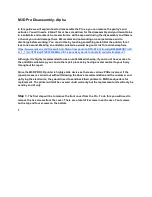
An example of increasing contrast would be setting punch1 to 0.2 and punch2
to 0.8. Input values between 0.0 and 0.2 are mapped to black (0.0) and input
values between 0.8 and 1.0 are mapped to white (1.0).
Intermediate values between punch1 and punch2 are linearly mapped, or
stretched, between 0.0 and 1.0.
An example of decreasing contrast would be setting punch1 to less than 0.0
and punch2 to more than 1.0. No shadow values are mapped to black (0.0), but
to higher values and all highlight values are mapped to lower values; that is,
values that are at least slightly gray.
Whenever punch1 is greater than punch2, the tone-scale of the image is
reversed. What was darker becomes lighter, and what was lighter becomes
darker.
6.6.2 Setting the Sharpness
The sharpness parameter controls the emphasis of the edge detail. The actual
value used depends on the quality of the image data in the source file and user
preference.
For
Set Sharpness
to...
Notes
Architectural pictures,
landscapes
2.0–4.0
Values below 2.0 may make pictures look dull and
soft.
Values above 4.0 may make pictures appear harsh
and unnatural.
Portraits
1.0–2.5
Values above 3.0 may make pictures look grainy.
Images to process faster
0.0
The image does not undergo sharpness process,
thus speeding up the processing time. 0.0 does not
affect the image quality.
Set the value high enough to produce the same edge detail as in the original
image, but low enough to prevent the exaggeration of imperfection and haloing
around edges. A sharpness value between 0 and
01
causes blurring. A value
below
01
has no additional effect and should not be used.
6–8 Enhancing Picture Quality




































